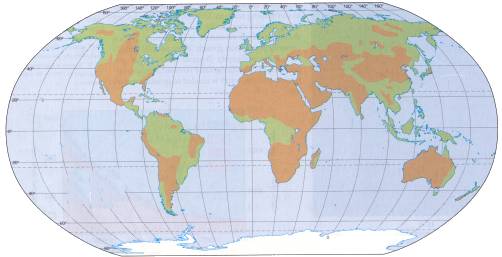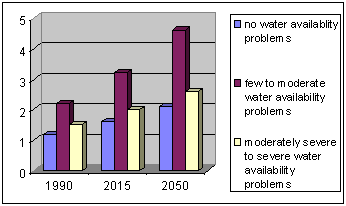 |
Global Availability |
|
The combined groundwater and surface water runoff described provides approximately 41 000 km3/yr (cubic kilometres per year). Of this 41,000 km3 it is estimated that 9000 km3 is easily accessible, providing "renewable" freshwater that can potentially be used year after year without ever depleting the freshwater resources of the world. The remaining 31,000km3 is lost as flood runoff or flow into the sea in uninhabited areas. Although also a "renewable" freshwater supply it is considered to be too unpredictable and too dispersed to be an economically viable as a water source. Currently, we use approximately 4,000 km3 of the freshwater circulating through the hydrological cycle, less than half of the available reserve. However regional and local shortages exist because the hydrological system doesn't distribute water evenly across the planet and water resource mismanagement also occurs. Figure 1 shows the regions of water surplus (green) and deficit (brown) in the world. Not surprisingly the amount of water used in different countries varies enormously, in the West a typical person uses up to 300 litres of water, in India this is reduced to only 25 litres per day. In the USA total water use per capita is 5300 litres per day, this includes industry and agricultural use and indicates vast differences in life style. Table 1 gives estimates of water used during the manufacture of some agricultural and industrial products. |
 |
| Figure 1: Areas of water deficit or shortage are shown in brown, areas of water surplus are shown in green. |
| Product | Water Use | |
| gallons | litres | |
| Egg | 52 | 234 |
| 1 glass of milk | 130 | 515 |
| 2.2kg of flour | 98 | 441 |
| 2.2kg of rice | 728 | 3276 |
| 2.2kg beef | 1040 | 4680 |
| 1 gallon crude oil refined | 13 | 58 |
| Sunday Paper | 364 | 1638 |
| 2.2kg Aluminium | 1300 | 5850 |
| 1 Car | 130,000 | 585,000 |
|
Nearly half the world's population lack an adequate supply of safe drinking water and with populations set to rise the pressure on water resources will only increase. It has been suggested that if the annual renewable freshwater available per person within a country falls below 1000 m3 (water scarcity), lack of water begins to hamper health, economic development and human well being.
|
| Country/Year | 1955 | 1990 | 2025 |
| Malta | 96 | 85 | 69 |
| Singapore | 459 | 221 | 181 |
| Somalia | 2500 | 980 | 363 |
| Egypt | 2561 | 1123 | 630 |
| Cyprus | 1698 | 1282 | 996 |
| India | 5277 | 2464 | 1496 |
| United Kingdom | 2344 | 2090 | 1992 |
| Sudan | 11899 | 4792 | 1993 |
| Iraq | 18441 | 6029 | 2356 |
| Mexico | 11396 | 4226 | 2597 |
| Japan | 6091 | 4428 | 4306 |
| Netherlands | 8371 | 6023 | 5093 |
| Hungary | 11704 | 10897 | 11062 |
| Luxembourg | 16394 | 13405 | 11682 |
|
Data for the early 1990's already indicates that a number of countries use almost all of their available renewable water supplies, Belgium, Malta, Israel an Egypt use more than 70% of their available resource. Whilst countries such as Libya, Qatar, Saudi Arabia, United Arab Emirates and the Yemen actually exceed (use more) than their annual renewable supply partly by using desalination plants but also by using groundwater from non-renewable aquifers. Table 2 shows 3 countries were already experiencing water scarcity in 1990, increasing to 5 by 2025, of which 3 would be experiencing absolute scarcity. Similarly Figure 2 shows the availability of fresh water to population, estimated to 2050. The number of people facing severe water shortage according to UNEP will increase by 70% to 2.1 billion by 2015 and by 2050 will have almost doubled (2.8 billion). There will also be increases in the number of people who will face moderate water shortages. |
|
 |
|
|
Figure 2 Availability of fresh water by number of people (year vs. population in billions)
Source: United Nations Environment Program (UNEP) 1997 |
|
|
Already, 26 countries have more people than their water supplies can adequately support. Africa currently has 11 water-scarce countries. By the end of this decade, four others will join the list, and the total number of Africans living in water- scarce countries will climb to 300 million, a third of the continent's projected population. The Middle East, where 9 out of 14 countries are water-scarce, suffers the most concentrated scarcity in the world today. Achieving water balance in some regions will not be possible without a slowdown in population growth. At current growth rates, the populations of 18 of the 20 countries now qualifying as water-scarce in Africa and the Middle East will double within 30 years. It is unlikely that technological advances alone will be able to solve these problems. |
|
 |
Ghana
In poor communities it is the women who bear the burden of collecting the day's water for their families. All too often they damage their health, and spend hours every day carrying huge containers of water - over 22kg (40lb) in weight - sometimes from sources several miles away. Then, after all the effort of collecting the water, very often it is not clean and safe. Untreated water causes diarrhoea, dysentery, and other health problems, which can be lethal, especially for young children. The picture (left) shows a hand pump fitted by Oxfam last year in the Zawara Village, northern Ghana. Photo: S Errington Source: http://www.oxfam.org.uk/atwork/emerg/womans_work.htm |